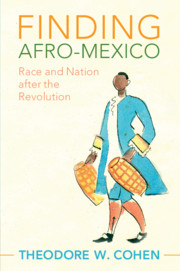Book contents
- Finding Afro-Mexico
- Afro-Latin America
- Finding Afro-Mexico
- Copyright page
- Dedication
- Contents
- Figures and Maps
- Acknowledgments
- Abbreviations
- Introduction
- Part I Making Blackness Mexican, 1810–1940s
- Part II Finding Afro-Mexico, 1940s–2015
- 4 Looking Back to Africa
- 5 Africanizing “La bamba”
- 6 Caribbean Blackness
- 7 The Black Body in Mexico
- Conclusion
- Bibliography
- Index
7 - The Black Body in Mexico
from Part II - Finding Afro-Mexico, 1940s–2015
Published online by Cambridge University Press: 17 April 2020
- Finding Afro-Mexico
- Afro-Latin America
- Finding Afro-Mexico
- Copyright page
- Dedication
- Contents
- Figures and Maps
- Acknowledgments
- Abbreviations
- Introduction
- Part I Making Blackness Mexican, 1810–1940s
- Part II Finding Afro-Mexico, 1940s–2015
- 4 Looking Back to Africa
- 5 Africanizing “La bamba”
- 6 Caribbean Blackness
- 7 The Black Body in Mexico
- Conclusion
- Bibliography
- Index
Summary
Chapter 7 explains how African Americans and Mexicans, especially Gonzalo Aguirre Beltrán and Miguel Covarrubias, looking to make blackness socially visible, articulated two disparate definitions of what and who was authentically African-descended. With the nation’s African heritage outlined by 1946, ethnographers and cultural producers began to identify African-descended communities in the contemporary ethnographic landscape, thereby integrating the descendants of African slaves into the political debates about mestizaje, socioeconomic modernization, and social justice nationally and regionally. To render blackness socially visible, a Mexicanized variation of the black body, usually the racially and culturally mixed mulatto, emerged in the national imaginary and in specific locales in Veracruz and along the Costa Chica of Guerrero and Oaxaca. Conversely, among Black Nationalists in the United States, Mexico blossomed into an archeological, historical, and ethnographic site for the study of Afro-diasporic peoples and cultures. Concerned with the silencing of black cultural ingenuity and historical agency globally, they articulated a vision of racial identity oriented more toward a corporeal definition of the black body than the cultural constructions of social visibility expressed by Mexican social scientists and policy makers.
Keywords
- Type
- Chapter
- Information
- Finding Afro-MexicoRace and Nation after the Revolution, pp. 222 - 266Publisher: Cambridge University PressPrint publication year: 2020

